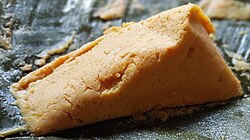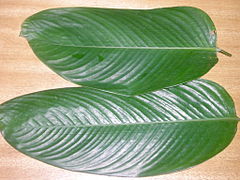
Ogun or Ogoun is a Yoruba spirit that appears in several African religions. He attempted to seize the throne after the demise of Ọbàtálá, who reigned twice, before and after Oduduwa, but was ousted by Obamakin and sent on an exile – an event that serves as the core of the Ọlọ́jọ́ Festival. Ògún is a warrior and a powerful spirit of metal work, as well as of rum and rum-making. He is also known as the "god of iron" and is present in Yoruba religion, Santería, Haitian Vodou, West African Vodun, and the folk religion of the Gbe people.

Synsepalum dulcificum is a plant in the Sapotaceae family, native to tropical Africa. It is known for its berry that, when eaten, causes sour foods subsequently consumed to taste sweet. This effect is due to miraculin. Common names for this species and its berry include miracle fruit, miracle berry, miraculous berry, sweet berry, and in West Africa, where the species originates, agbayun, taami, asaa, and ledidi.

Ugali, also known as posho, nsima, and other names, is a type of corn meal made from maize or corn flour in several African countries, Kenya, Uganda, Tanzania, Malawi, Botswana and South Africa It is cooked in boiling water or milk until it reaches a stiff or firm dough-like consistency. In 2017, the dish was added to the UNESCO Representative List of the Intangible Cultural Heritage of Humanity, one of a few foods in the list.

Àmàlà is a staple swallow food originating from Nigeria popularized by the Yoruba ethnic group of Southwestern Nigeria and other parts of Yorubaland. It is made of yam, cassava flour, or unripe plantain flour. Tubers of yams are peeled, sliced, cleaned, dried and then ground into flour. It is also called èlùbọ́. Yams are white in colour but turn brown when dried which gives àmàlà its colour. It is a popular side dish served with ewédú and gbẹ̀gìrì, but is also served with a variety of other ọbè(soups), such as ẹ̀fọ́, ilá, and ogbono.

Spondias mombin, also known as yellow mombin, hog plum, amra or cajazeira, is a species of tree and flowering plant in the family Anacardiaceae. It is native to the tropical Americas, including the West Indies. The tree was introduced by the Portuguese in South Asia in the beginning of the 17th century. It has been naturalized in parts of Africa, India, Nepal, Bangladesh, Sri Lanka, The Bahamas, Indonesia, and other Caribbean islands. It is rarely cultivated except in parts of the Brazilian Northeast.

Ghanaian cuisine refers to the meals of the Ghanaian people. The main dishes of Ghana are centered around starchy staple foods, accompanied by either sauce or soup as well as a source of protein. The primary ingredients for the vast majority of soups and stews are tomatoes, hot peppers, and onions. As a result of these main ingredients, most Ghanaian soups and stews appear red or orange.
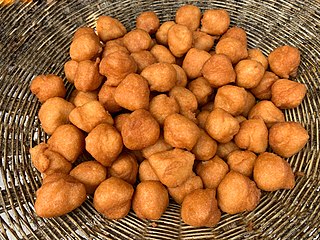
Àkàrà (Yoruba) (English: bean cake; Hausa: kosai; Portuguese: acarajé is a type of fritter made from cowpeas or beans by the Yoruba people of Nigeria, Togo and Benin. It is found throughout West African, Caribbean, and Brazilian cuisines. The dish is traditionally encountered in Brazil's northeastern state of Bahia, especially in the city of Salvador. Acarajé serves as both a religious offering to the gods in the Candomblé religion and as street food. The dish was brought by enslaved Nigerian citizens from West Africa, and can still be found in various forms in Nigeria, Ghana, Togo, Benin, Mali, Gambia, Burkina Faso and Sierra Leone.

Draw soup is the name of soups from the southeastern and southwestern parts of Nigeria that are made from okra, ogbono(Irvingia gabonensis), or ewedu leaves (jute). The name derives from the thick viscosity characteristic of the broth as it draws out of the bowl when eaten either with a spoon or, more characteristically, by dipping a small piece of solid (fufu) into it. It can be served with numerous Nigerian fufu meals, including eba (garri) and pounded yam. Ewedu can be used to make a Yoruba soup that is traditionally served with amala.

Fried plantain is a dish cooked wherever plantains grow, from West Africa to East Africa as well as Central America, the tropical region of northern South America and the Caribbean countries like Haiti to Cuba and in many parts of Southeast Asia and Oceania, where fried snacks are widely popular. In Indonesia it is called gorengan. It is called dodo in Yoruba in South West Nigeria, otherwise known as simply fried plantain in other parts of Nigeria. Kelewele is a fried spicy plantain or can be fried as a side dish for Red Red and fish stew in Ghana.

Nigerian cuisine consists of dishes or food items from the hundreds of Native African ethnic groups that comprises Nigeria. Like other West African cuisines, it uses spices and herbs with palm oil or groundnut oil to create deeply flavored sauces and soups.

Thaumatococcus daniellii, also known as miracle fruit or miracle berry, is a plant species from tropical Africa of the Marantaceae family. It is a large, rhizomatous, flowering herb native to the rainforests of western Africa in Sierra Leone, southeast to Gabon and the Democratic Republic of the Congo. It is also an introduced species in Australia and Singapore.
Frejon is a coconut milk and bean soup which is eaten especially during Holy Week by a selection of Christians, mostly Catholics, across the world. Countries where Frejon is popular include Brazil and Nigeria, and also Sierra Leone on Good Friday, or for functions such as weddings. Because dairy foods and flesh meat are strictly forbidden on Good Friday, this dish is a suitable accompaniment to non-dairy foods such as fried fish and peppered snail.
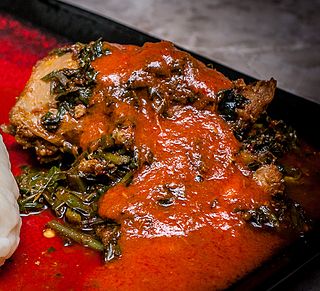
Efo riro is a vegetable soup and a native soup of the Yoruba people of South West Nigeria and other parts of Yorubaland. The two vegetables most commonly used to prepare the soup are Celosia argentea and Amaranthus hybridus. The history of Efo riro is deeply rooted in the Yoruba culture. It was traditionally prepared with the locally grown vegetables, meat, fish, and a mixture of spices. The choice of vegetables and proteins varies based on personal preference and regional availability. The most commonly used vegetables are spinach, pumpkin leaves, or sorrel leaves, often combined with bell peppers, chili peppers, and onions.
Ekuru is a very common native cuisine of the Yoruba people in Nigeria. It is usually prepared with peeled beans.

Ofada rice is a Yoruba dish. It is the name of an indigenous rice from a small community called Ofada, located in the Obafemi Owode Local Government Area of Ogun State. It is not exclusively grown in the community, but it is an indigenous rice grown in southwest Nigeria but named after the Ofada community. It is used in making a variety of dishes. Ofada rice are mostly blends, and some of the rice varieties in the blends are not indigenous to Africa; however, they usually also contain African rice. It is grown almost exclusively in Ogun State, a state in southwestern Nigeria. Ofada rice is grown on free-draining soil where the water table is permanently below the root of the plant.
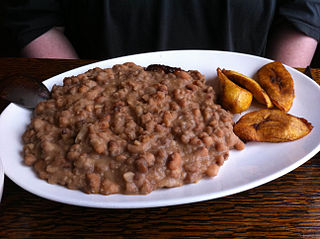
Ewa aganyin (Yoruba) (also spelled as Ewa agoyin) is a Yoruba dish commonly eaten in Yorubaland across Togo, Nigeria and Benin. It is also popular as street food. The dish consists of beans cooked until extremely soft and then mashed. Other ingredients, such as bell peppers, onion, ginger, dried chilies and palm oil, are added to form a stew. It is commonly eaten with bread, a popular combination in Africa.

Àbùlà is a soup of Yoruba people from Western Nigeria. It is typically eaten together with amala, but can be eaten with other swallow foods. Abula literally means a mixture of soups but is mostly associated with a mixture of gbegiri, ewedu and ọbẹ̀ata (stew).
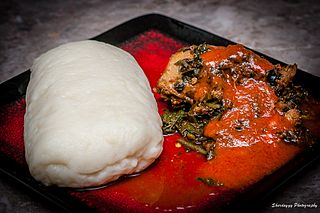
Pounded yam or ‘’’Utara-ji or Nni-ji’’’(Igbo)Iyán (Yoruba) or Ruam-Yo (Tiv) is a Nigerian swallow food native to the Yoruba, Igbo Edo, Tiv and Ebira ethnic groups. It is a traditional food prepared by pounding boiled yam with a mortar and pestle. Pounded yam is similar to mashed potatoes but heavier in consistency. It is a smooth and tasty delicacy traditionally eaten with the hands.
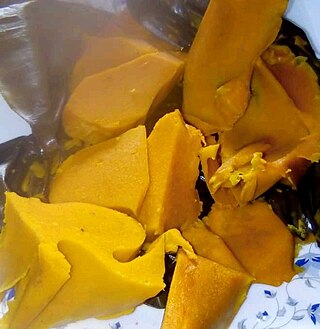
Okpa is a dish prepared by the Igbo people with a type of beans known as Bambara nuts. It is common in Enugu state and classified as a traditional Nigerian delicacy. It is not exclusively eaten by the Igbo, nor is it universal among the Igbo ; other ethnic groups often eat it, and it may be that this is most-common in Niger State. Other Igbo names for okpa include ịgba and ntucha. In Hausa, it is known as gurjiya or kwaruru.

Yoruba cuisine is the numerous and diverse foods of the Yoruba people of Yorubaland. Some notable Yoruba food include : Ofada, Asaro, Moi Moi, Egusi soup, Abula, Akara, Ila Alaspo, Eforiro with Okele, etc.
